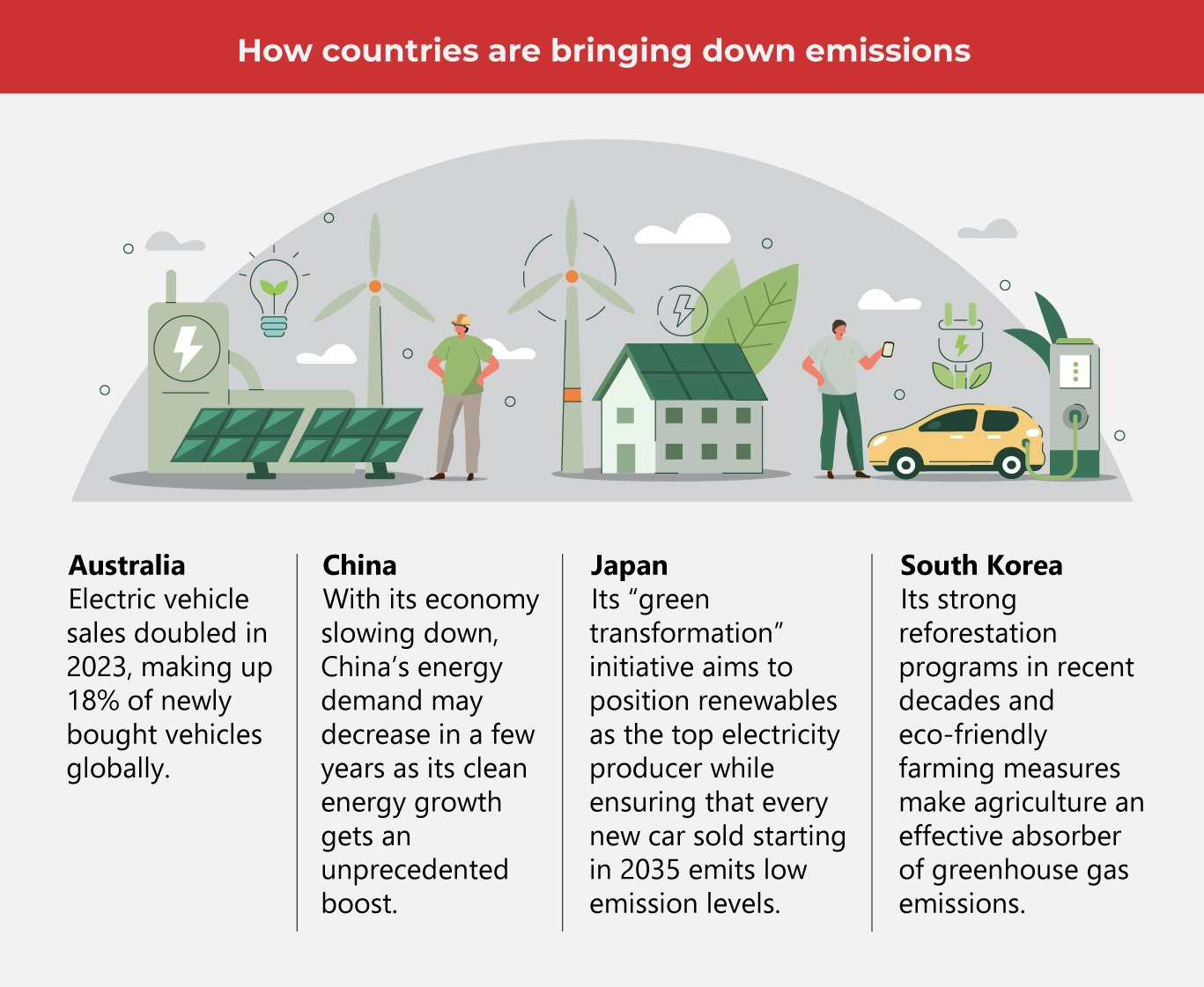Did Carbon Emissions Peak in 2023?

Global emissions are on the uptrend, hitting peak figures. But instead of interpreting it as bad news, environmental scientists look at the bright side. When greenhouse gas emissions peak, it also means that global warming elements have stopped going up and started going down. It’s a significant game changer as the world gears up to save itself.
According to the World Emissions Clock, 2023 will record the highest emissions volume, about 59 Gigatons of greenhouse gasses, equivalent to 2,000 tonnes produced per second. This alarming uptrend of emissions has reached a point where it’s about one-third more than what’s needed to keep global warming in control.
Proof of this is continuously rising temperatures. Last year was the hottest ever recorded by a wide margin. In fact, the EU-initiated Copernicus Climate Change Service reported that 2023 temperatures were 1.48°C higher than pre-industrial levels. This is already close to the 1.5°C limit the Paris Agreement set. Beyond this temperature, the situation poses significant risks for humanity.
Last year’s heat fueled global disasters like the Canadian and Hawaiian wildfires, fatal heatwaves in the northern hemisphere, and unprecedented rainfall in China and Korea. With the world’s oceans recording the warmest temperatures in history, the ice in Antarctica’s ocean was over a million square kilometers less than the lowest amount ever recorded.
Hope for the planet
During the United Nations climate conference in December 2023, almost 200 countries agreed to accelerate the move away from fossil fuels in the next ten years. They decided that the combustion of fossil fuels mainly drives the climate emergency.
If these participants fulfill their promises, 2023 will be the year carbon emissions peak because from then on, these will start to go down. Change won’t be instant and constant across different parts of the world, but recent examples demonstrate that shifting to a cleaner economy is possible through technology and funding.
The Intergovernmental Panel on Climate Change emphasizes that peaking before 2025 is crucial in staying within the 1.5°C limit. This means we must act now to reach that goal. According to a Climate Analytics report, if efforts to address global warming continue, along with the growth of renewable energy trends, there is a 70% likelihood that emissions will begin to decline in 2024. This effectively achieves the IPCC’s target date.
Reasons for this positive outlook
Why are environmental scientists seeing the bright side? It’s not just blind faith. Recent developments and trends point to a promising transition to sustainability on a global scale. Here are some of them:
-
Growth of renewable energy
Along with emissions, coal and gas usage peaks can also happen in 2023 and 2024, respectively. This is due to the impressive growth of solar and wind technologies, which would slowly inch out fossil fuels as the top players in the energy sector. Sustained clean energy initiatives over the next two years are crucial, including using electric vehicles and united action to avoid methane. Improving energy efficiency and maximizing green technologies globally can also significantly lower emissions.
-
More demand for green energy
There has been an uptick in global market demand for clean energy innovations, overriding harmful systems like coal-fueled electricity and petrol-powered vehicles. This shift in consumer behavior creates market diversity and competition, which can drive sustainable energy advancements, boosting efficiency and affordability. By choosing green alternatives, consumers can directly contribute to overall lower emissions.
-
The rise of renewable energy infrastructure
The World Economic Forum stresses the importance of infrastructure in hitting net-zero emissions. While infrastructure is a steady and reliable investment option even when markets are unpredictable, it provides the base for the global clean energy system. To boost this development, public and private sectors must work together to set up suitable infrastructure in various industries.
-
Increased investments
The International Energy Agency (IEA) reveals that global clean energy investments have amounted to US$1 trillion in 2023—180% more than fossil fuel expenditure. If present policies are maintained, clean energy spending would be 2.5 times higher than spending on fossil fuels by 2030. While some would argue that this is due to higher upfront costs in developing renewables, this would be cost-effective in the long run because of reduced operating costs and more robust energy security.
-
Global energy crisis
While international conflicts like the Russian invasion on Ukraine spurred the global energy crisis, these also shifted the attention away from the use of fossil fuels. This triggered momentum for clean energy transitions, which may eventually lower the world’s demand for coal, petrol, and natural gas. Still, IEA clarifies that even with this shift, oil and gas will play a major market role in the coming decades.
Also read: Can Carbon Capture Help Solve Climate Change?
What needs to be done
Emissions may peak, but much more must be done to make a difference. Here are some expert recommendations to sustain the momentum.
-
Meet the clean energy demand
Emissions need to decrease quickly and consistently over the years after the peak. IEA warns that reducing oil and gas spending won’t be enough; the solution lies in increased investment in all facets of a clean energy network. This way, the sector can meet the rising clean energy demand in a sustainable manner.
-
Support from all sectors
The public and private sectors should all support clean energy efforts instead of hampering them. This way, countries can take full advantage of their potential benefits, including industrial and employment prospects, widespread access to energy, and a safer environment for all.
-
Fast-track pro-environment action
IEA has put together measurable goals to phase out fossil fuels by 2030. Some of these are tripling clean energy, doubling energy efficiency, and cutting down methane emissions by more than 30%. Investments in clean energy should be boosted by more than double, especially in developing nations. Additionally, fossil fuel operations should decrease by 40% within the decade.
More than ever, governments must show their commitment to cutting down emissions and follow it up with effective action this decade. While transitioning to low-carbon technologies is inevitable, time is of the essence. The sooner it happens, the better.
As one of the Top 20 EMS companies in the world, IMI has over 40 years of experience in providing electronics manufacturing and technology solutions.
We are ready to support your business on a global scale.
Our proven technical expertise, worldwide reach, and vast experience in high-growth and emerging markets make us the ideal global manufacturing solutions partner.
Let's work together to build our future today.
Other Blog



